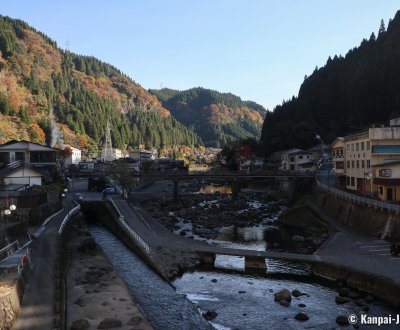Tsuetate Onsen
Forgotten Thermal Village in Kumamoto
Tsuetate Onsen is a thermal village belonging to Oguni City and located in the north-east of Kumamoto Prefecture on Kyushu Island in Japan. This old touristic spot renowned for its hot springs is now popular for the quaint and retro looks of its center’s narrow Sedoya streets and its Hizen-ya ryokan-hotel.
Tsuetate Onsen ♨️ spa town is located in the heart of a beautiful steep valley at the limits of Kumamoto and Oita prefectures. Its handful of picturesque buildings spread on the side of the Tsuetate river.

A historical, yet mysterious thermal resort
Tsuetate’s hot spring has long been believed to be good for health, and even having supernatural properties. Several legends do indeed tell that its natural water could extent life expectancy by a 1,000 years.
The origin of the village’s name is linked to monk Kukai (774 – 835) also known as Kobo Daishi, the founder of the Shingon Buddhist school and of the Koya-san monastery. While on a pilgrimage in Kyushu in the early 9th century, Kukai stopped by a river and shoved his pilgrim’s rod in the ground. The rod turned into a tree, growing branches and leaves, the monk thus named the place Tsuetate:
- 杖 tsue meaning "rod" or "staff"; and,
- 立 tate translating as "standing" or "upright".
Another legend tells that elderly or sick people who had to walk with a cane could be healed by immersing in Tsuetate Onsen’s water, therefore leaving their canes behind after a bath in the miraculous water.
Tsuetate’s touristic boom happened in the 1930s: the village established its reputation as a paradise lost for wealthy travelers thanks to its beautiful surrounding nature. In the postwar period, the resort gradually lost its influence. Now, the once very busy, large onsen facilities are a display of the nostalgia of the town’s golden age and of the Showa era (1926 – 1989). The unique old-fashioned atmosphere, that can stir up a melancholic feeling at nightfall, now makes the appeal of this resort with a glorious past.
The village’s streets are called Sedoya and are sprawling on the mountains in crooked and steep paths, enlivened by the hot spring’s steam oozing from air vents. A couple of small shrines and temples embellish the town; the 3 bridges crossing the river are all ornamented with a statue of Jizo Bosatsu. The mushi-ba 蒸し場, which are pavilions for cooking with the onsen’s steam, are open to anyone who brings their own food: there you can steam hard eggs, vegetables (sweet potatoes) or fish.

Hizen-ya, the large multi-centennial ryokan inn
Hizenya Tsuetate Kanko Hotel 🏨 (つえたて温泉ひぜんや) is an accommodation and thermal facility founded in 1690, and it celebrated its 330th anniversary in 2020. Being the largest hotel-ryokan in Tsuetate Onsen, it is spreading on 9 floors, with:
- 143 rooms;
- A restaurant;
- A large reception hall for private events;
- A bowling;
- A game arcade and several karaoke rooms; and,
- Separated baths, one for men and one for women.
The place is huge, especially the onsen spaces such as Bungo no yu bath, a feeling reinforced as the ryokan does not seem very busy. The inn is now rather a stopover for groups traveling the area more than a destination where to relax over a weekend. While the facility may look outdated and old, service is top-notched with clean rooms and a delicious traditional cuisine.
The inn’s building is located exactly on the frontier between Kumamoto and Oita prefectures, which is shown by a line on the floor at each level. The detail is important as it is a big help to navigate inside the facility. Hizen-ya is indeed a complex structure akin to a maze! It is standing on the bank of the Tsuetate river, before the road, and the ground floor as well as the 2nd, 3rd and 4th floors can’t be accessed from outside. The only entrance is at the 5th floor, at road level, where the inn’s lobby is. Upon check-in, staff provide a map of the hotel that should be kept carefully and used to find your way in the maze-like corridors!

Tsuetate Onsen is a forgotten rural spa resort that seems frozen in its past glory. However, it is still in activity and the local tourist office is working with the resort’s twenty hotels and shops to continue offering quality spa stays in a now quiet and retro ambiance. Tsuetate’s landscape is also known as the origin of the tradition of hanging koinobori 🎏 carp garlands above rivers each spring in Japan 🌸, between April and May.

